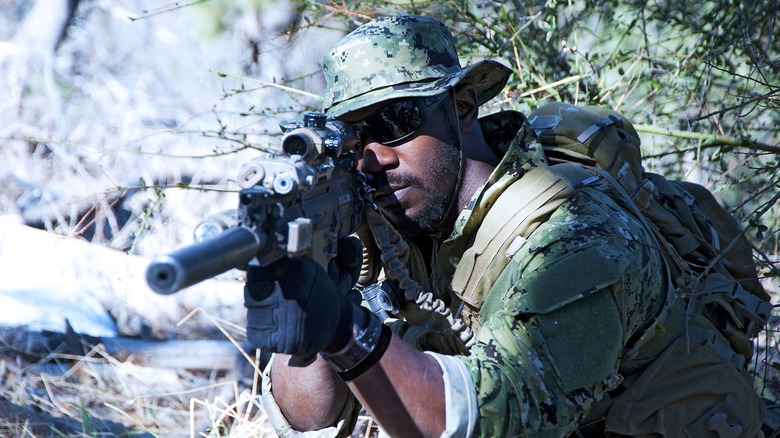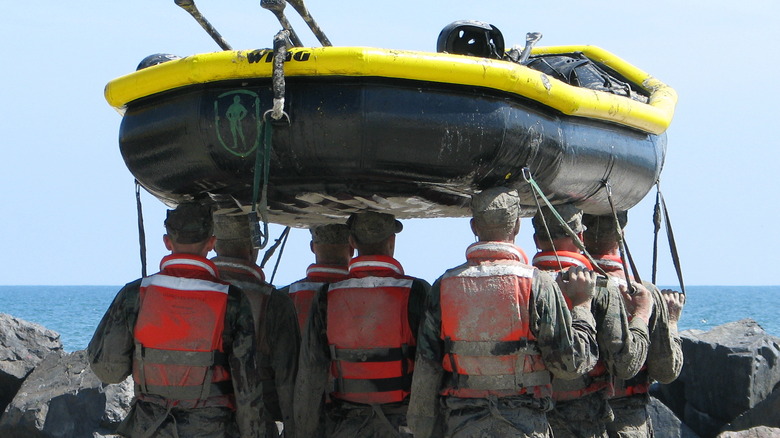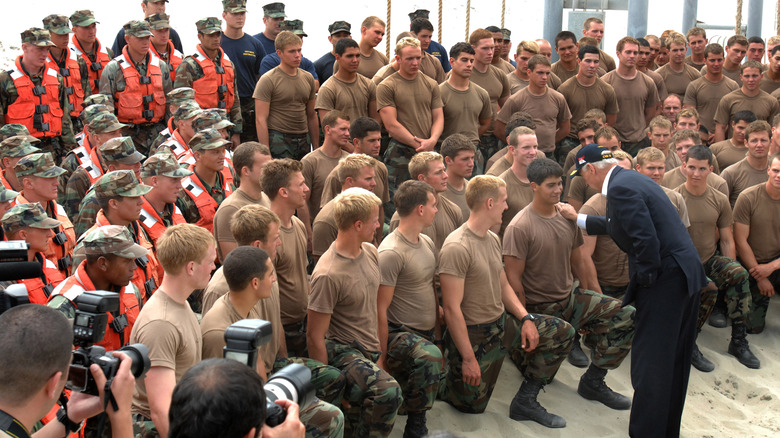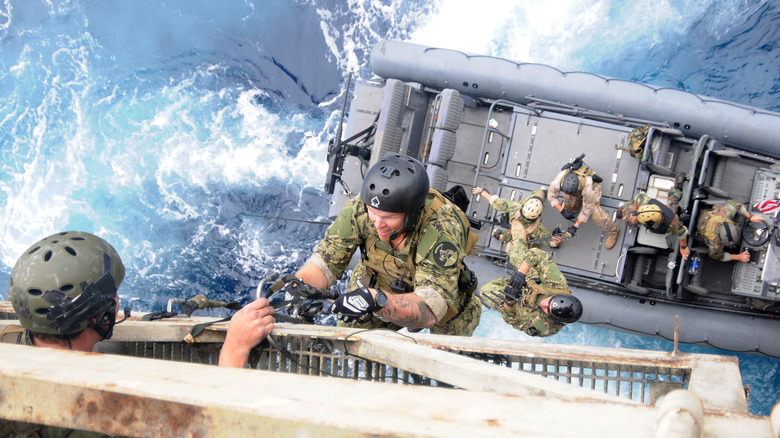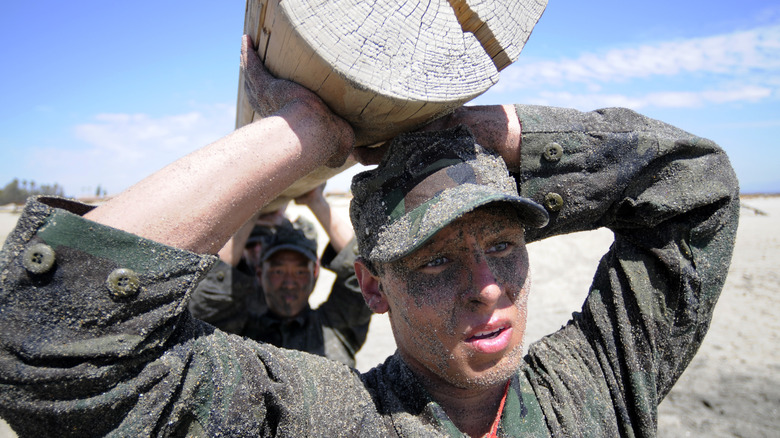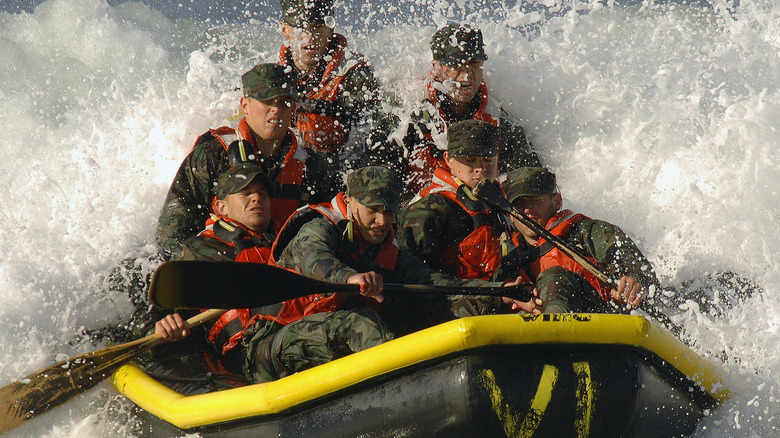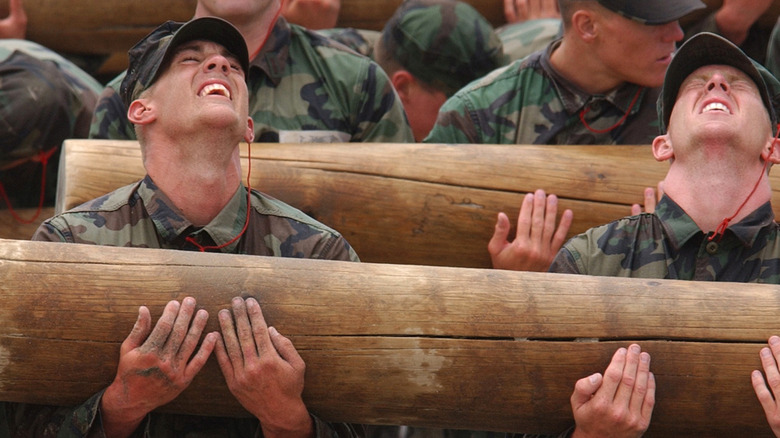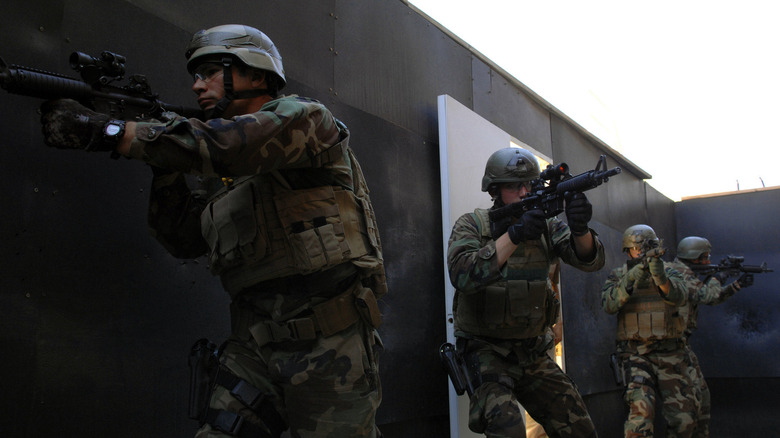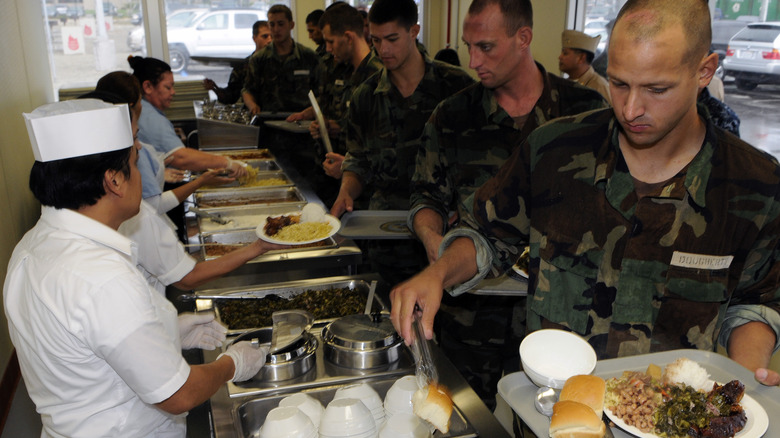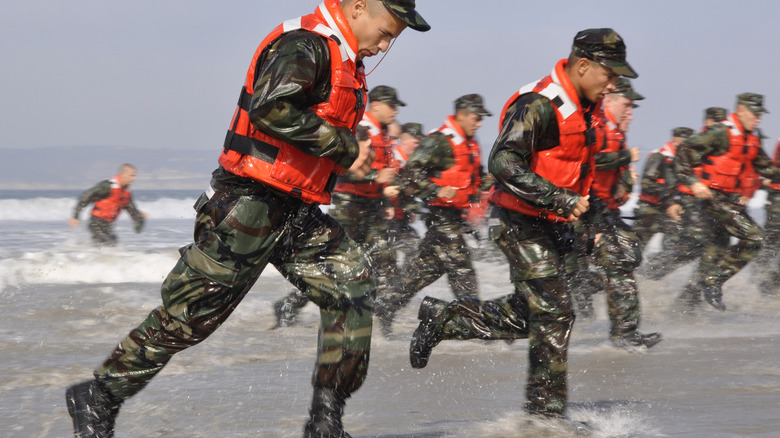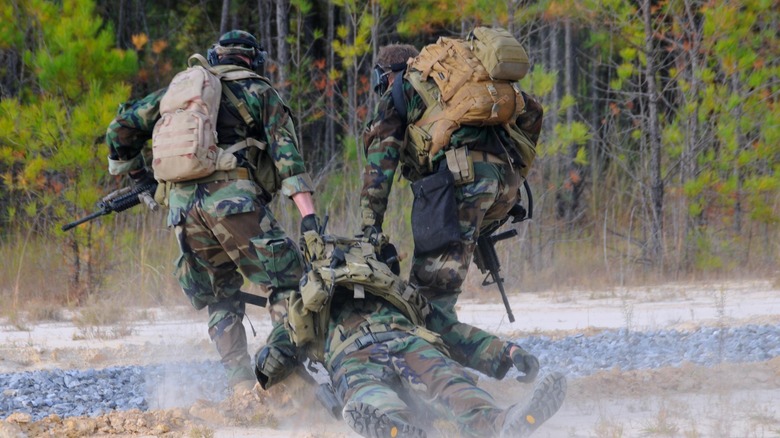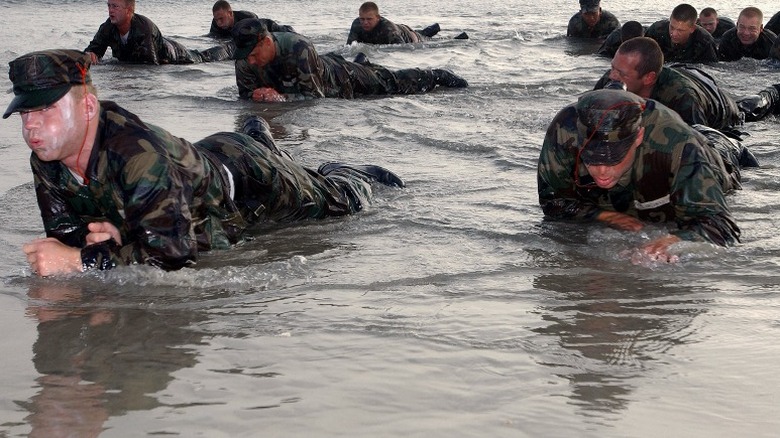Navy SEALs: The Untold Truth Of Hell Week
A branch of the United States Navy, the SEAL program produces elite soldiers for some of the military's toughest special ops missions. They're the soldiers called in when what needs doing has to be done quietly and quickly. From reconnaissance to direct action, they get in and get out, and do not fail. A combination of quick wits, skill, and sheer toughness, the Navy SEAL is more than just an ordinary soldier. And to shape a Navy recruit into a SEAL is more than just drills and exercises. SEAL training requires being put through a notorious six-day gauntlet commonly referred to as "Hell Week."
What is Hell Week? Appropriately named, it's "one of the toughest crucibles of SEAL training, [and] one of the biggest things that builds the SEAL mindset ... designed to weed out those who truly aren't fully committed to becoming a SEAL," said retired Navy SEAL Jason Redman in a recent video interview with CNN. Think you've got what it takes to make it through? Read the untold truth of Navy SEAL's Hell Week and think again.
It's the toughest training program in the U.S. military
According to Hell Week's section on the U.S. Navy's official website, the rigorous program is famed for being "the toughest training in the U.S. Military." But once completed, it does more than simply anoint a trainee a Navy SEAL, as many graduates of the program consider it their ultimate accomplishment and something they take immeasurable pride in. It proves to themselves and others just what they are truly capable of, because the program puts them through rigors that nobody who has never done it could ever imagine.
According to the Daily Beast, trainees spend about five days undergoing intense physical activity, like running, swimming in freezing water, lifting and carrying heavy objects, and crawling over tough terrain. But if you think the physical tests sound simple, they are anything but. Trainees are subjected to these rigorous physical tests with little to no respite and are pushed to their absolute physical and mental limit. Hell Week is not just for the strong, it's for the strongest, the bravest, and the most mentally sharp, and the toughest of spirit. Physical exercises are hard enough, but they are conducted while instructors are putting the trainees under extraordinary mental and psychological stresses as well.
It just one part of six months of 'pure hell'
According to The New York Daily News, in 2011, candidates had to do 20 pull-ups and more than 100 pushups in under two minutes, plus be able to swim 500 yards in less than nine minutes. And that's all before being allowed to go through Hell Week. Because Hell Week isn't the only training a would-be Navy SEAL must undergo, and they only allow the toughest candidates to take the final test. Hell Week is just one small part of six whole months of intense training known as Basic Underwater Demolition/SEAL (BUD/S).
Those first few weeks of BUD/S helps to thin out the herd so to speak — to get "most of the quitters out first," said Stew Smith, a former SEAL who served from 1991-1999. "Then they teach you how to be a SEAL." It's a total of 25 weeks of strengthening exercises and tests to evaluate endurance and other physical modes of measure, as well as to prepare recruits for the final trials. Candidates who successfully complete Hell Week are further put through an even tougher series of exercises, both on land and at sea, as Military.com details. Miles of swimming, running, and paddling, all under the weight of full Navy gear.
Few trainees successfully pass
Remember the old expression, the one you probably heard when you were an incoming college freshman? You were told to look left and look right and realize that only one of the three of you would be graduating. If you didn't get that lecture, you've probably heard of it — but for the Navy SEAL trainees who are put through Hell Week, it's even worse than that. The intensive training is meant to weed out the weaker candidates, who are instructed to ring a bell when they want to quit, according to the New York Daily News. "The instructors ... understood many of us would be at a low ebb," recounts former SEAL Marcus Lutrell (via the Daily Beast). "They moved among us, imploring us to quit now while there was still time."
But even during their final trials it's estimated — by the Navy themselves, according to their own website — that just 25% of SEAL candidates who undergo Hell Week even make it through successfully. It's a brutal test to ensure only the best of the best of the best are awarded the honor of being America's Navy SEALS. Those who make it out the other side can truly say they have the strength, stamina, endurance, and determination that most people simply do not possess. It's the ultimate assessment of toughness, and the odds of success and rate of failure definitely reflect that.
It's as much mental as physical
A common misconception of the SEAL's Hell Week is that it's all about physical strength and endurance. That an ability to complete the physical tests themselves is all you need to beat it; that if you can run, swim, paddle, do enough sit-ups, push-ups, and log rolls than you'll have what it takes to be a Navy SEAL. But as much as the training program is to ensure candidates are strong, tough, and capable physically, it's also a supreme test of their mind, their steadiness, their emotional fortitude, and their sheet determination.
During Hell Week, soldiers-in-training are put through a gauntlet of challenges, all while being pushed to their emotional and mental limits with stresses induced by instructors. Trainees are kept uncomfortable: cold, tired, and in pain, with little let-up. As stated on their website, Hell Week forces out recruits more through as much mental strain than physical. When a trainee quits, it's more their minds as the enemy rather than their bodies giving up. But once a recruit passes Hell Week, they often feel invincible, like they can accomplish anything. And that's the goal, because SEALs are given the toughest missions, such as the one that located and took down Al Qaeda mastermind Osama Bin Laden in 2011 (via 911memorial.org).
There are some seriously scary psychological tests
In the book, "Lone Survivor," by Marcus Luttrell (via The Daily Beast), the former Navy SEAL detailed a number of his experiences from his final training during Hell Week, including some of the extraordinary lengths that instructors would go to in order to push the recruits' nerves. In one harrowing ordeal, Navy instructors barreled into their barracks unannounced, late at night, with guns blazing. "Suddenly there was a loud shout, and someone literally kicked open the side door. Bam! And a guy carrying a machine gun, followed by two others, came charging in, firing from the hip. The lights went off, and then all three gunmen opened fire, spraying the room with bullets," Luttrell recounted.
With no idea what was happening — whether these were live rounds or blanks — the trainees hit the deck and held themselves motionless for what must have seemed like eternity. The point of the exercise was to frighten and confuse them, and it did just that. "For the next couple of minutes there was nothing but gunfire, deafening gunfire," Luttrell wrote. "They were certainly blanks, otherwise half of us would have been dead, but believe me, they sounded just like the real thing, SEAL instructors firing our M43s. The shouting was drowned by the whistles, and everything was drowned by the gunfire."
Luttrell had been told Hell Week would be an unprecedented test of his nerves, and after this and other shocking psychological tests, he believed it.
Hell Week prepares trainees for the toughest missions
If you think Hell Week is a bit too much, consider the caliber of soldier needed to complete its incredible missions. In the history of the Navy SEALS, the elite soldiers have been responsible for some of the most daring single-unit operations in military history, including "Operation Neptune Spear" (the takedown of Osama Bin Laden), "Gothic Serpent" (an operation that was a part of the Battle of Mogadishu in Somalia in the early 1990s), and the capture of Manuel Noriega. They also played large roles in various conflicts from Operation Desert Storm to operations in Iraq and Afghanistan. And these are just the ones that have been declassified and released to the public.
In 2009, they also famously took part in the rescue of Richard Phillips, the now famous captain of the merchant ship Maersk Alabama, after a small group of Somali pirates took over the ship and held him at gunpoint in April. As Wired details, a team of SEALS arrived on the scene and took out three pirates, when they believed they were ready to kill Phillips. After the mission was debriefed to the public, it was turned into the Hollywood movie "Captain Phillips," starring Tom Hanks, with actor Max Martini playing the SEAL commander.
Trainees are told to quit
To ensure that the men and women who go through Hell Week truly prove themselves to be the most determined, spiritually fit, and mentally strong individuals, they go to great lengths to tempt them to abandon the program itself. Ex-SEAL Marcus Luttrell, in his book "Lone Survivor," described how instructors attempted to goad the stressed and struggling recruits to ring the bell and quit. Though Luttrell said that he was never tempted, "the instructors understood this would not be true of everyone." Moving man to man, they would tell them they could end the struggle right then and there. "All you gotta do is ring that little bell up there."
Of course, while undergoing Hell Week, Luttrell would witness man after man leave, overwhelmed by the intensity of the course. He would describe the scene when crawling amid sand and surf, one trainee got up and left. "Right next to me, one of the top guys in the class, an officer and a boat-crew leader, great runner, good swimmer, quit unconditionally." He also described how a second trainee begged the quitter not to leave and then insisted to the instructor that his comrade wasn't serious about quitting. "The instructor gave him another chance, told him it wasn't too late and if he wished he could go right back into the water. But the man's mind was made up," wrote Luttrell.
There's almost no sleep
It isn't just physical rigors, mind games, stress, and psychological tricks that the instructors force recruits to endure. On top of all of the physical, mental, and emotional pressures they must suffer through, trainees are given little time and less opportunity to sleep and recover from the day's brutal, endless grind. It's an effort to prepare them for missions that might allow for little rest. According to former Navy SEAL John McGuire (via Business Insider), who is now a motivational speaker, the aspiring soldiers are permitted as little as just four total hours of sleep through the entirety of Hell Week.
According to Marcus Luttrell (via The Daily Beast), exercises and drills would begin early in the morning and continue uninterrupted throughout the day, and into the wee hours of the night, with no time to stop for a recharge. Deep into the night the men would work and push and work and push until their first respite: breakfast. But as soon as they finished wolfing down their chow, the next day's shift of instructors was barking orders. "That's it, children—up and out of here. Let's get going. Outside! Right now! Move! Move! Move! Let's start the day right."
Still wet from their march through the surf, still covered in sweat and dirt and grime, after working themselves to the bone all night, they were pushed right back out for more. "Right then I knew for certain: there was indeed no mercy in Hell Week," wrote Luttrell.
Quitting due to injury is common
With all of the stresses recruits are put through, it's important to ensure their safety and wellbeing. To that end, medical personnel is kept on-hand at all times throughout every phase of the program. Doctors and medics are there to keep a close eye on all trainees, who could suffer anything from mere exhaustion to a broken bones. According to Military.com, the sheer amount of running alone done by the trainees can easily lead to "overstress injuries." According to a guide to the program on the Navy's website, injuries are one of the main reasons why recruits will quit the course.
In fact, the Navy acknowledges that the practice of a trainee ringing a bell to quit the program is designed so that those who cannot endure the strain of the course or leave due to injury can accept defeat with dignity and honor. Once the bell is rung, instructors make the candidate's exit a simple one, with students even being allowed to indulge in coffee and donuts. This is all done in an effort to practice good character and sportsmanship, a key part of serving on a military team where looking out for one another is an important part of staying alive.
Injuries and deaths are not uncommon
Despite taking every precaution to keep the candidates safe, injuries are inevitable and range from minor cuts, scrapes, and abrasions, to serious life-threatening injuries. Sadly, even the death of a recruit is not uncommon.
In February of 2022, a man named Kyle Mullen, hailing from New Jersey, died after experiencing mysterious symptoms from an unknown illness just mere hours after his successful graduation from Hell Week. Since 1988, the Los Angeles Times reports at least six recruits have died during their training, including during Hell Week. In March 2001, 29-year-old Lt. John Skop Jr. was the first SEAL candidate to lose his life during Hell Week while undergoing a swimming exercise.
It's not just physical injuries either, as a young man sadly died by suicide in 2016 after washing out of the program. This caused serious concern for the Navy, especially as it came not long after two other deaths that preceded Hell Week. Capt. Jay Hennessey, commanding officer of the Naval Special Warfare Center, commented on the spate of deaths following the suicide, saying, "Despite a successful track record, any loss of life drives us to ensure we are doing everything possible to make training safe and effective," as per The Virginian-Pilot.
If you or anyone you know is having suicidal thoughts, please call the National Suicide Prevention Lifeline at 1-800-273-TALK (8255).
There was once a civilian version of Hell Week
For about a decade, anyone could undergo a version of Hell Week, thanks to former Navy SEAL Don Shipley. Shipley founded the "Extreme SEAL Experience," a course designed for civilians to simulate — as safely as possible for the uninitiated — the experience of what its like to become a SEAL. Though its since closed it doors, it was an incredible experience, and one reported on by ABC News' Ely Brown in 2012.
While it was in operation, the program gave the average Joe the opportunity to be pushed to the physical and mental limits in the same way as aspiring SEALs. From pushups and jumping jacks to log lifts and even simulated nighttime operations, those who paid the course's $1,890 entrance fee (or more depending on the tiered programs available) would "learn marksmanship on eleven different weapon systems, as well as fast rope, rappel, helo sniping, and various climbing techniques" and "receive training in tactics and close Quarter combat." Now closed, Shipley says on his website that several thousand people attended the training course while it was in operation.
